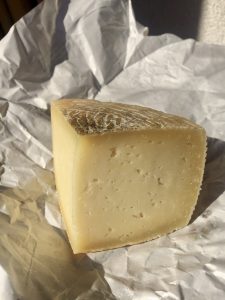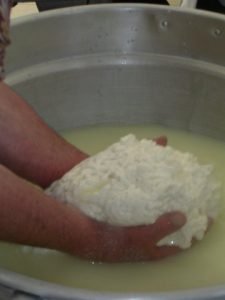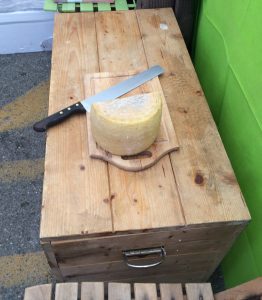This a monthly series which I have been publishing for years. You can subscribe here, to get the latest cheese delivered directly on to your screen.
It wasn’t easy to settle on a candidate for this month, after a whole row of wonderfully packed weeks traveling from cheese to cheese! But I’ll be working on that long list, promised. For October, let’s go south, once more, to Abruzzo, between the Gran Sasso mountains and Pescara on the Adriatic Sea, for a lesson on rennet: Pecorino di Farindola.

Yet another pecorino… ah well, some might think. But bear with me, this one is special, and I finally consciously encountered it, noticed it, in Bra, at Slow Cheese, primordial mother of all cheese festivals. Since ever, always (I know, that is a tricky notion, but its socio-psychological-philosophical consideration would lead us a little too far at this point) Pecorino di Farindola has been made using pigs‘ rennet. Not young, suckling piglets, which would at least halfway fit into the „rennet is the enzyme from the abomasum, the fourth stomach, of a suckling young ruminant“ logic – except for the ruminant, that is, as pigs are omnivores, just like us, and make do with one single stomach, just like us.

No, Francesca at the consorzio’s stall told me, seriously grown up, real pigs, weighing in up to 300 kilo! Their stomach is put up with salt, white wine, vinegar and some spices for half a year, and the resulting liquid used to coagulate the sheep’s milk. After one to one and a half hours (which is rather long), they’d stir the curd, heating it to 37°C, and ladle it into to woven moulds. The young cheeses are dry salted, then cleaned and finally left to mature at around 17°C in large wooden chests, being rubbed with olive oil occasionally. At some producers dark cultures develop, making for a black rind.

I tasted. Indeed, different, less concentrated-sheep’s-milk-yellow-citrus-zesty, but rounder, deeper, darker in aroma. And the texture even in mature cheeses still somewhat moist. Very good. But how does this pig rennet thing work? Worldwide web, help!
It helped. In a grown-up pig’s stomach (as in our own) hydrochloric acid turns the enzyme pepsinogen into pepsin which breaks down protein. Rennet from suckling ruminants does contain pepsin too, but its use for cheesemaking relies more on chymosin, present in much larger quantity. So: different, but similar. One more little piece figured out in the big jigsaw puzzle of cheese and life. And one more reason to travel to Abruzzo, besides the delicious wines.
This a monthly series which I have been publishing for years. You can subscribe here, to get the latest cheese delivered directly on to your screen.
If you enjoyed reading this, you might consider clicking on the button below and supporting me in my work. I’d be more than happy. Thank you.
